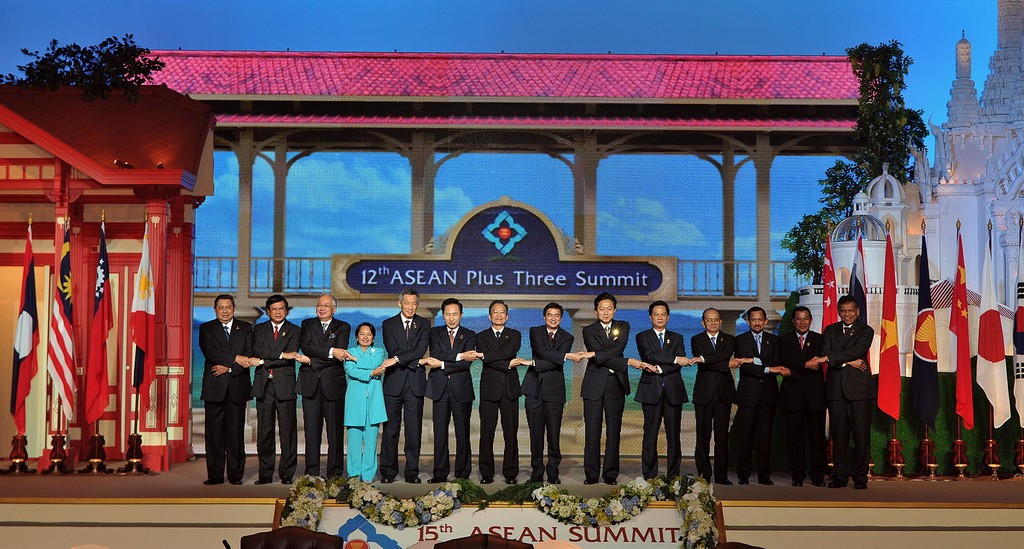
កិច្ចប្រជុំកំពូលអាស៊ានបូកបី លើកទី១២ នៅហួរហ៊ីន ព្រះរាជាណាចក្រថៃ។ រូបថត ថតដោយសាធារណរដ្ឋកូរ៉េ កាលពីថ្ងៃទី ២៤ ខែតុលា ឆ្នាំ២០០៩ ។ ក្រោមអាជ្ញាប័ណ្ណ CC BY-SA 2.0
ប្រទេសកម្ពុជា មានចំណងការទូតជាមួយនឹងប្រទេសជាច្រើន រាប់បញ្ចូលទាំងសាធារណរដ្ឋប្រជាមានិតចិន សហរដ្ឋអាមេរិក រាជាណាចក្រជប៉ុន សាធារណរដ្ឋបារាំង ចក្រភពអង់គ្លេស សាធារណរដ្ឋកូរ៉េខាងត្បូង និងសាធារណរដ្ឋប្រជាមានិតប្រជាធិបតេយ្យកូរ៉េខាងជើង។ ប្រទេស នេះ ជាសមាជិកអង្គការអន្តរជាតិជាច្រើន ដូចជា អង្គការសហប្រជាជាតិ និងទីភ្នាក់របស់អង្គការ នេះ។ ប្រទេសនេះ ក៏មានសមាជិកភាពនៅក្នុងសមាគមប្រជាជាតិអាស៊ីអាគ្នេយ៍ (អាស៊ាន) ធនាគារពិភពលោក មូលនិធិរូបិយវត្ថុអន្តរជាតិ (អាយ អឹម អេហ្វ) ធនាគារអភិវឌ្ឍន៍អាស៊ី (អេឌីប៊ី) អង្គការពលកម្មអន្តរជាតិ (អាយឡូ) និង អង្គការពាណិជ្ជកម្មពិភពលោក (ដាប់ប៊ែលយូ ធី អូ)។ កម្ពុជា ក៏ជាប្រទេសស្ថាបនិកនៃធនាគារអភិវឌ្ឍហេដ្ឋារចនាសម្ព័ន្ធអាស៊ី ផងដែរ។
អ្នកជិតខាងធំៗ: ប្រទេសថៃ និង ប្រទេសវៀតណាម
ប្រវត្តិសាស្ត្រមួយភាគធំនៃប្រទេសកម្ពុជា មានដានស្នាមមកទំនាក់ទំនងរបស់ខ្លួនជាមួយនឹង ប្រទេសថៃ និងប្រទេសវៀតណាម។ បើទោះបីប្រទេសថៃ គឺជាប្រទេសផ្គត់ផ្គង់ធំជាងគេបំផុត របស់ប្រទេសកម្ពុជា កាលពីអតីតកាល ប្រទេសទាំងពីរនេះ ធ្លាប់ដណ្តើមផ្នែកខ្លះនៃព្រំដែនសមុទ្រ និងដី ដែលមិនទាន់បានកំណត់ច្បាស់លាស់។ ការទាស់ទែងគ្នានេះ បានឈានដល់ជម្លោះប្រដាប់ អាវុធនៅរវាងឆ្នាំ២០០៨ និងឆ្នាំ២០១១ ជាពិសេសនៅជុំវិញប្រាសាទព្រះវិហារល្បីល្បាញ នៅលើព្រំដែនភាគខាងជើង នៃប្រទេសកម្ពុជា។
យ៉ាងណាក៏ដោយ ទំនាក់ទំនងរវាងប្រទេសកម្ពុជា និងប្រទេសថៃ មានការរីកចម្រើនគួរកត់សម្គាល់ នៅក្នុងប៉ុន្មានឆ្នាំថ្មីៗនេះ ។ ទំហំពាណិជ្ជកម្មរវាងប្រទេសទាំងពីរ មាន ៥.១ប៊ីលាន ដុល្លារអាមេរិក នៅឆ្នាំ២០១៤ ដែលបង្ហាញពីកំណើន ១១ភាគរយ បើធៀបនឹងឆ្នាំ២០១៣។ ការនាំចេញរបស់ប្រទេសកម្ពុជា ទៅប្រទេសថៃ បានហក់ឡើងជាង ១០០ភាគរយ នៅក្នុងរយៈ ពេល ៩ខែ នៃឆ្នាំ២០១៥។1
តាមរបាយការណ៍ មន្ត្រីនៃប្រទេសទាំងពីរ មើលឃើញពីសក្តានុពល ក្នុងការបង្កើនពាណិជ្ជកម្ម ទ្វេភាគី ឱ្យបាន ៣០ភាគរយ ក្នុងមួយឆ្នាំ ចាប់ពីឆ្នាំ២០១៦ រហូតដល់ឆ្នាំ២០២០។ កន្លែងត្រួត ពិនិត្យនៅព្រំដែន ចំនួន ៦កន្លែង នាពេលបច្ចុប្បន្ន នឹងត្រូវបង្កើនឡើងរហូតដល់ ១០ កន្លែង។2
ការឆ្លងដែនខុសច្បាប់មកពីប្រទេសកម្ពុជា ទៅប្រទេសថៃ កើតឡើងក្នុងទ្រង់ទ្រាយធំ ដូចគ្នាទៅ នឹងការនិរទេសខ្លួនត្រឡប់មកប្រទេសកម្ពុជាវិញដែរ។ លោក ឡាយ គីមលន់ ប្រធាននគរបាល ប្រឆាំងការជួញដូរមនុស្សប្រចាំខេត្តបន្ទាយមានជ័យ ត្រូវបានស្រង់សម្តីកាលពីខែធ្នូ ឆ្នាំ២០១៥ ថា ចាប់ពីដើមឆ្នាំមក ប្រជាជនកម្ពុជា ចំនួន ៥៥,៦២៦ នាក់ ត្រូវបានចាប់បញ្ជូនខ្លួនមកវិញដោយអាជ្ញាធរថៃ តាមច្រកត្រួតពិនិត្យប៉ោយប៉ែត។3
ប្រទេសវៀតណាម គឺជាប្រភពនៃការនាំចូលទំនិញមួយដ៏សំខាន់ ហើយក៏ជាទីផ្សារនាំចេញសំខាន់ សម្រាប់ប្រទេសកម្ពុជា ផងដែរ។ ប៉ុន្តែ ជាមួយនឹងជម្លោះរវាងអ្នកតវ៉ាព្រំដែន និងវៀតណាម ភាពតានតឹងលើបញ្ហាព្រំដែន រឹតតែតឹងតែងឡើងនៅឆ្នាំ២០១៥ ។ ក្រសួងការបរទេស និងសហប្រតិបត្តិការអន្តរជាតិ នៃប្រទេសកម្ពុជា បានបញ្ជូនកំណត់ការទូតតវ៉ារាប់សិប ជម្រុញ អាជ្ញាធរវៀតណាម ឱ្យបញ្ឈប់សកម្មភាពនៅតាមព្រំដែន ដែលធ្វើឱ្យប៉ះពាល់ស្ថានការណ៍បច្ចុប្បន្ន។ នៅចុងឆ្នាំ២០១៥ រដ្ឋមន្ត្រីក្រសួងមហាផ្ទៃ បានដាក់បញ្ជាទៅគ្រប់អាជ្ញាធរមូលដ្ឋាន ឱ្យហាមឃាត់ប្រជាជនកម្ពុជា ដែលមានដីនៅជាប់នឹងព្រំដែនវៀតណាម មិនឱ្យជួលទៅកសិករវៀតណាម។4
នៅរវាងខែកក្កដា ឆ្នាំ២០១៤ និងខែមិថុនា ឆ្នាំ២០១៥ អាជ្ញាធរកម្ពុជា បាននិរទេសជនអន្តោប្រវេសន៍វៀតណាមខុសច្បាប់ ចំនួន ២,០៥៨នាក់។5
ប្រទេសចិន
ប្រទេសចិន គឺជាមហាអំណាចសកលលោក ដែលប្រទេសកម្ពុជា មានទំនាក់ទំនងយ៉ាងជិតស្និទ្ធ ជាមួយ។ នៅខែធ្នូ ឆ្នាំ២០១០ ប្រទេសទាំងពីរ បានបង្កើនទំនាក់ទំនងទៅដល់កម្រិត “ភាពដៃគូរ ជាយុទ្ធសាស្ត្រគ្រប់ជ្រុងជ្រោយ”។ ពាណិជ្ជកម្ម រវាងប្រទេសទាំងពីរ បានរីកធំធាត់ពី ២.៣៤ប៊ីលានដុល្លារអាមេរិក នៅឆ្នាំ២០១២ ទៅប្រមាណជា ៣.៣ប៊ីលានដុល្លារអាមេរិក នៅឆ្នាំ ២០១៣ ជាមួយនឹងកិច្ចព្រមព្រៀងបង្កើនពាណិជ្ជកម្មរហូតដល់ ៥ប៊ីលានដុល្លារអាមេរិក នៅត្រឹម ឆ្នាំ២០១៧។6
វិនិយោគចិន នៅក្នុងវិស័យហេដ្ឋារចនាសម្ព័ន្ធនៃប្រទេសកម្ពុជា មានចំនួនច្រើនគួរជាទីកត់សម្គាល់។ ឧទាហរណ៍ តាមរបាយការណ៍ ក្រុមហ៊ុនចិន បានវិនិយោគជាង ១.៦ប៊ីលានដុល្លារ ដើម្បីសាងសង់ទំនប់វារីអគ្គិសនីចំនួន ៦ នៅក្នុងព្រះរាជាណាចក្រកម្ពុជា។7
ប្រទេសទាំងពីរ គឺជាអ្នកគាំទ្រខាងនយោបាយខ្លាំងខ្លា ឱ្យគ្នាទៅវិញទៅមក។ ចាប់តាំងពីការចាកចេញពីទំនាក់ទំនងផ្លូវការជាមួយនឹងតៃវ៉ាន់ នៅឆ្នាំ១៩៩៧មក ប្រទេសកម្ពុជា គឺជាអ្នកគាំទ្រយ៉ាងមុតមាំលើគោលនយោបាយ ‘ចិនតែមួយ’។8
នៅដើមឆ្នាំ២០០០ ប្រទេសចិន លុបចោលបំណុលប្រមាណជាជិត ១ប៊ីលានដុល្លារអាមេរិក ដែល កម្ពុជាជំពាក់ នៅក្នុងអំឡុងទសវត្សរ៍ទី ១៩៧០ (ប្រទេសចិនបានផ្តល់កម្ចីភាគច្រើនសម្រាប់ សម្ភារៈសង្គ្រាម)។9
នៅពេលសហរដ្ឋអាមេរិក និងសភាពអឺរ៉ុប ស្នើប្រទេសកម្ពុជាឱ្យស៊ើបអង្កេតដោយឯករាជ្យ ទៅលើ ការសង្ស័យអំពីភាពមិនប្រក្រតី បន្ទាប់ពីការបោះឆ្នោតជាតិឆ្នាំ២០១៣ ប្រទេសចិនគាំទ្រភ្លាមៗ ចំពោះលទ្ធផលនៃការបោះឆ្នោត និងអបអរសាទរនាយករដ្ឋមន្ត្រី ហ៊ុន សែន និងគណបក្សរបស់ លោក អំពីជោគជ័យរបស់ពួកគេ។10
ប្រធានាធិបតីចិន ស៊ី ជីនពីង បានធ្វើទស្សនៈកិច្ចនៅប្រទេសកម្ពុជានៅក្នុងខែ តុលា ឆ្នាំ ២០១៦។ យោងតាមសេចក្តីរាយការណ៍តាមប្រព័ន្ធផ្សព្វផ្សាយ កិច្ចព្រមព្រៀង និងអនុស្សរណៈយោគយល់គ្នាចំនួន ៣១ ត្រូវបានធ្វើឡើងវវាងប្រទេសប្រទសទាំងពីរ ក្នុងអំឡុងពេលទស្សនៈកិច្ចនេះ ដែលរួមមានកិច្ចព្រមព្រៀងផ្តល់កម្ចីប្រមាណជិត ២ ពាន់លានដុល្លារ សម្រាប់ការអភិវឌ្ឍហេដ្ឋារចនាសម្ព័ន្ធផ្លូវថ្នល់ និង ១៨០ លានដុល្លារទៀតជាជំនួយហិរញ្ញវត្ថុ។11
សហរដ្ឋអាមេរិក
សហរដ្ឋអាមេរិក គឺមានសារៈសំខាន់ខាងសេដ្ឋកិច្ចជាខ្លាំងចំពោះប្រទេសកម្ពុជា។ អាមេរិក ទិញប្រមាណជា មួយភាគបី នៃការនាំចេញរបស់ប្រទេសកម្ពុជា ភាគច្រើនជាសម្លៀកបំបាក់ និង ស្បែកជើង។ នៅឆ្នាំ២០១៤ ពាណិជ្ជកម្មទ្វេភាគី មានតម្លៃជិត ៣.២ប៊ីលានដុល្លារអាមេរិក ប៉ុន្តែ មានអតុល្យភាពខាងជញ្ជីងពាណិជ្ជកម្មខ្លាំង៖ សហរដ្ឋអាមេរិក នាំចូល ២.៨៤ប៊ីលានដុល្លារ អាមេរិកមកពីប្រទេសកម្ពុជា ខណៈដែលនាំចេញតែ ៣២៨លានដុល្លារអាមេរិក ទៅព្រះរាជាណាចក្រកម្ពុជា។12
នៅឆ្នាំ២០១៤ ជំនួយការបរទេសរបស់សហរដ្ឋអាមេរិក សម្រាប់សុខភាព អប់រំ អភិបាលកិច្ច កំណើនសេដ្ឋកិច្ច និងការដោះគ្រាប់មិនទាន់ផ្ទុះ មានតម្លៃសរ៉ុប ៧៤.៥ លានដុល្លារអាមេរិក។13
តាមសម្តីរបស់អ្នកសង្កេតការម្នាក់បានឱ្យដឹងថា ភាគខុសគ្នាមួយ ក្នុងបណ្តាភាពខុសគ្នាសំខាន់ៗ ជាច្រើនរវាងការគ្រប់គ្រងជំនួយរបស់អាមេរិក និងចិន គឺថា “ជំនួយរបស់សហរដ្ឋអាមេរិក តែងភ្ជាប់មកជាមួយលក្ខខណ្ឌតឹងតែង ខណៈដែលជំនួយរបស់ប្រទេសចិនពុំមានភ្ជាប់លក្ខខណ្ឌ”។14 ចាប់ពីឆ្នាំ១៩៩៨ មកដល់ឆ្នាំ២០០៧ សភាអាមេរិក បានហាមឃាត់ជំនួយផ្ទាល់ ឬជំនួយរដ្ឋាភិបាលនិងរដ្ឋាភិបាល មកប្រទេសកម្ពុជា ក្នុងគោលបំណងដាក់សម្ពាធរាជរដ្ឋាភិបាល កម្ពុជា ឱ្យស្តារប្រជាធិបតេយ្យពេញលេញ។15
ប្រធានាធិបតី អូបាម៉ា បានក្លាយជាប្រធានាធិបតីអាមេរិកក្នុងតំណែងទី១ មកទស្សនកិច្ចនៅប្រទេសកម្ពុជា ក្នុងអំឡុងកិច្ចប្រជុំកំពូលអាស៊ីខាងកើត កាលពីខែវិច្ឆិកា ឆ្នាំ២០១២។ ទោះបីជា យ៉ាងណា នៅក្នុងកិច្ចប្រជុំរបស់ប្រធានាធិបតី អូបាម៉ា ជាមួយនឹងនាយករដ្ឋមន្ត្រី ហ៊ុន សែន វាបានបង្ហាញច្បាស់ថា វឌ្ឍនភាពយឺតយ៉ាវខាងប្រជាធិបតេយ្យ និងសិទ្ធិមនុស្ស គឺជាបញ្ហា ដែល រាំងស្ទះដល់ទំនាក់ទំនងជិតស្និទ្ធជាមួយនឹងប្រទេសកំពុងអភិវឌ្ឍ។16
ប្រទេសជប៉ុន
ចាប់តាំងពីឆ្នាំ១៩៩២មក ប្រទេសជប៉ុន បានផ្តល់ជំនួយអភិវឌ្ឍន៍ដល់ប្រទេសកម្ពុជា ជាង ២ប៊ីលាន ដុល្លារអាមេរិក និងនៅតែជាប្រទេសម្ចាស់ជំនួយធំបំផុតរបស់ប្រទេសកម្ពុជា។17 ប្រទេស ជប៉ុន ផ្តល់អាទិភាពជំនួយរបស់ខ្លួនលើវិស័យហេដ្ឋារចនាសម្ព័ន្ធ រាប់បញ្ចូលទាំងការភិវឌ្ឍបណ្តាល ផ្លូវ ប្រព័ន្ធអគ្គិសនីស្ថេរភាព និងការអភិវឌ្ឍបច្ចេកវិទ្យាព័ត៌មាន និងគមនាគមន៍។18
នៅដើមឆ្នាំ២០១៥ ប្រទេសជប៉ុន បានយល់ព្រមផ្តល់ ៣៦លានដុល្លារអាមេរិក មកប្រទេសកម្ពុជា ក្រោមកម្មវិធីជំនួយអភិវឌ្ឍន៍ និងជិត ២០០លានដុល្លារអាមេរិក ជាកម្ចីសម្បទាន សម្រាប់កែលម្អ ហេដ្ឋារចនាសម្ព័ន្ធ និងមន្ទីរពេទ្យ។19
ប្រទេសកម្ពុជា តែងតែគាំទ្រជានិច្ចចំពោះប្រទេសជប៉ុន នៅក្នុងការប្រកួតប្រជែងសម្រាប់អាសនៈ អចិន្ត្រៃយ៍ នៅក្រុមប្រឹក្សាសន្តិសុខអង្គការសហប្រជាជាតិ។20
ប្រទេសរ៉ុស្ស៊ី
នៅឆ្នាំ២០១៥ ទំនាក់ទំនងរវាងប្រទេសកម្ពុជា និងប្រទេសរ៉ុស្ស៊ី បានអភិវឌ្ឍគួរជាទីកត់សម្គាល់ ជាមួយនឹងដំណើរទស្សនកិច្ចរបស់នាយករដ្ឋមន្ត្រីរ៉ុស្ស៊ី មកកាន់ប្រទេសកម្ពុជា។ នៅក្នុងបណ្តា កិច្ចព្រមព្រៀង និងសេចក្តីសម្រេចដែលត្រូវបានធ្វើឡើង ប្រទេសរ៉ុស្ស៊ីបានយល់ព្រមលុបបំណុល ៧០ភាគរយ នៃបំណុលសរុបប្រមាណជា ១.៥ ប៊ីលានដុល្លារអាមេរិក មកពីអំឡុងទសវត្សរ៍ ទី១៩៧០ ដែលសាធារណរដ្ឋប្រជាមានិតកម្ពុជា បានជំពាក់។21
អ្នកវិនិយោគបរទេសធំៗ: ចិន កូរ៉េខាងត្បូង ជប៉ុន វៀតណាម ម៉ាឡេស៊ី និង ថៃ ។
ទីផ្សារនាំចេញសំខាន់ៗ: សហរដ្ឋអាមេរិក ចក្រភពអង់គ្លេស អាឡឺម៉ង់ កាណាដា សិង្ហបុរី និង វៀតណាម។
ប្រភពនាំចូលសំខាន់ៗ: ថៃ វៀតណាម ចិន និង សិង្ហបុរី។
ទាក់ទងនឹងទំនាក់ទំនងអន្តរជាតិ
បច្ចុប្បន្នភាពចុងក្រោយ ២ វិច្ឆិកា ២០១៦
ឯកសារយោង
- 1. ម៉ៃ គុណមករា. “ការជម្រុញបន្ថែមពាណិជ្ជកម្មកម្ពុជា-ថៃ ត្រូវការចាំបាច់.” ខ្មែរថាម. ថ្ងៃទី៣០ ខែវិច្ឆិកា ឆ្នាំ២០១៥។ ចូលអាននៅថ្ងៃទី ២៧ ខែវិច្ឆិកា ឆ្នាំ២០១៥។ http://bit.ly/1kim9aI
- 2. ដូចខាងដើម។
- 3. សាំង សុឥន្ទរិទ្ធ. “ជនចំណាកស្រុកជាង ៥,០០០នាក់ត្រូវបានចាប់បញ្ជូនដោយថៃ នៅឆ្នាំ២០១៥.” ឌឹ ខេមបូឌា ដេលី ថ្ងៃទី ៧ ខែធ្នូ ឆ្នាំ២០១៥។ ចូលអាននៅថ្ងៃទី ២៧ ខែវិច្ឆិកា ឆ្នាំ២០១៥។https://www.cambodiadaily.com/news/more-than-50000-migrants-deported-by-thailand-in-2015-102223/
- 4. ប៉ាវ ស៊ុយ និង វែន រដ្ឋាវង្ស. “នាយករដ្ឋមន្រ្តីហាមការជួលដីនៅតាមបណ្តោយព្រំដែន”. ខ្មែរថាម. ថ្ងៃទី១៥ ខែវិច្ឆិកា ឆ្នាំ២០១៥។ ចូលអាននៅថ្ងៃទី ២៧ ខែវិច្ឆិកា ឆ្នាំ២០១៥។http://www.khmertimeskh.com/news/17838/pm-bans-land-leasing-along-border/
- 5. ឈឿងបូរាណ ចាន់បូរី. “ការតម្រង់យុទ្ធសាស្រ្តត្រឹមត្រូវរបស់កម្ពុជាជាមួយចិន.” ឌឹ ឌីផ្លូមម៉ាត. ថ្ងៃទី ៨ ខែកក្កដា ឆ្នាំ២០១៥។ ចូលអាននៅថ្ងៃទី ២៧ ខែវិច្ឆិកា ឆ្នាំ២០១៥។ http://thediplomat.com/2015/07/cambodias-strategic-china-alignment/
- 6. ដូចខាងដើម។
- 7. ថូមម៉ាស ឡាំ. ប្រទេសកម្ពុជា៖ សវតារ និងទំនាក់ទំនងសហរដ្ឋអាមេរិក ដោយសង្ខេប. ថ្ងៃទី១១ ខែឧសភា ឆ្នាំ២០១៥. សេវាស្រាវជ្រាវសភា។ ចូលអាននៅថ្ងៃទី ២៧ ខែវិច្ឆិកា ឆ្នាំ២០១៥។https://www.fas.org/sgp/crs/row/R44037.pdf
- 8. បុគ្គលិកសារព័ត៌មាន ឌឹ ខេមបូឌា “នាយករដ្ឋមន្រ្តីលើកឡើងជាថ្មីអំពីគោលនយោបាយ’ចិនតែមួយ’.” ឌឹ ខេមបូឌា ដេលី ថ្ងៃទី ២៧ ខែមីនា ឆ្នាំ២០០០។ ចូលអាននៅថ្ងៃទី ២៧ ខែវិច្ឆិកា ឆ្នាំ២០១៥។https://www.cambodiadaily.com/archives/prime-minister-reiterates-one-china-policy-15932/
- 9. ឯក មាត្រា. “រ៉ុស្ស៊ីត្រឡប់មករកកម្ពុជាវិញ.” ខ្មែរថាម. ថ្ងៃទី៣០ ខែវិច្ឆិកា ឆ្នាំ២០១៥។ ចូលអាននៅថ្ងៃទី ២៣ ខែធ្នូ ឆ្នាំ២០១៥។ http://www.khmertimeskh.com/news/18216/russia-comes-back-to-cambodia/
- 10. វ៉ា វាសនា. “កម្ពុជា៖ រវាងចិន និងសហរដ្ឋអាមេរិក.” ឌឹ ឌីផ្លូមម៉ាត. ថ្ងៃទី ២០ ខែឧសភា ឆ្នាំ២០១៥។ ចូលអាននៅថ្ងៃទី ២៧ ខែវិច្ឆិកា ឆ្នាំ២០១៥។ http://thediplomat.com/2015/05/cambodia-between-china-and-the-united-states/
- 11. ស៊ុំ ម៉ាណេត, “ប្រទេសចិនផ្តល់ ២ ពាន់លានដុល្លារសម្រាប់ផ្លូវថ្នល់ និងស្ពាន”. កាសែតខ្មែរថាមស៍, ចុះថ្ងៃទី ១៧ ខែ តុលា ឆ្នាំ ២០១៦។
- 12. ថូមម៉ាស ឡាំ ឆ្នាំ២០១៥។
- 13. ក្រសួងការបរទេសសហរដ្ឋអាមេរិក. “ទំនាក់ទំនងសហរដ្ឋអាមេរិក ជាមួយកម្ពុជា.” ថ្ងៃទី ២៩ ខែសីហា ឆ្នាំ២០១៤។ ចូលអាននៅថ្ងៃទី ២៧ ខែវិច្ឆិកា ឆ្នាំ២០១៥។ https://www.state.gov/u-s-relations-with-cambodia/
- 14. វ៉ា វាសនា ឆ្នាំ២០១៥។
- 15. ដូចខាងដើម។
- 16. វីលៀម ថត. ទំនាក់ទំនងសហរដ្ឋអាមេរិក-កម្ពុជា៖ កិច្ចការកំពុងបន្ត. ព្រឹត្តិប័ត្ររបស់ឯកអគ្គរដ្ឋទូត. និទាឃរដូវឆ្នាំ២០១៣។
- 17. ស៊ីម៉ន ហេនឌឺសិន. “ជប៉ុនផ្តល់២៣៦លានដុល្លារអាមេរិកជាជំនួយអភិវឌ្ឍន៍និងកម្ចី .” ឌឹ ខេមបូឌា ដេលី ថ្ងៃទី ២៧ ខែមីនា ឆ្នាំ២០១៥។ ចូលអាននៅថ្ងៃទី ២៣ ខែធ្នូ ឆ្នាំ២០១៥។
- 18. ស្ថានទូតជប៉ុនប្រចាំនៅកម្ពុជា. “ជំនួយអភិវឌ្ឍន៍ផ្លូវការ.” ចូលអាននៅថ្ងៃទី ២៩ ខែវិច្ឆិកា ឆ្នាំ២០១៥។ http://www.kh.emb-japan.go.jp/economic/economic-e.htm
- 19. ស៊ីម៉ន ហេនឌឺសិន ឆ្នាំ២០១៥។
- 20. ឈាង វណ្ណារិទ្ធិ. កម្ពុជា៖ រវាងចិន និងជប៉ុន. វិទ្យាស្ថានកម្ពុជាដើម្បីកិច្ចសហប្រតិបត្តិការនិងសន្តិភាព. ឯកសារលេខ៣១. រាជធានីភ្នំពេញ. ខែ តុលា ឆ្នាំ២០០៩។ http://bit.ly/1U6Bjft
- 21. ឯក មាត្រា ឆ្នាំ២០១៥។

